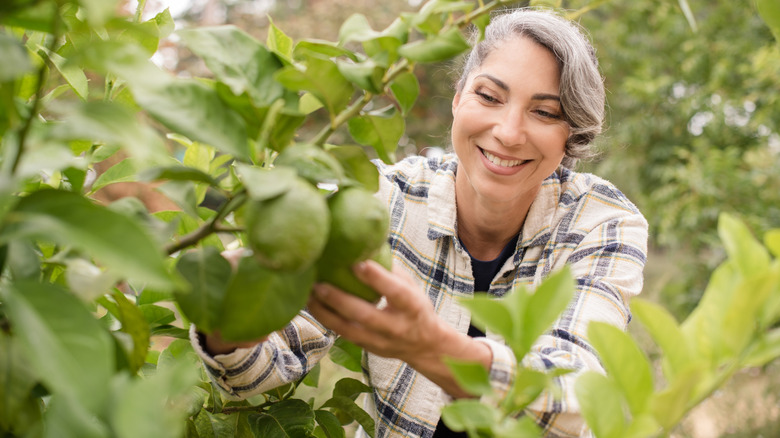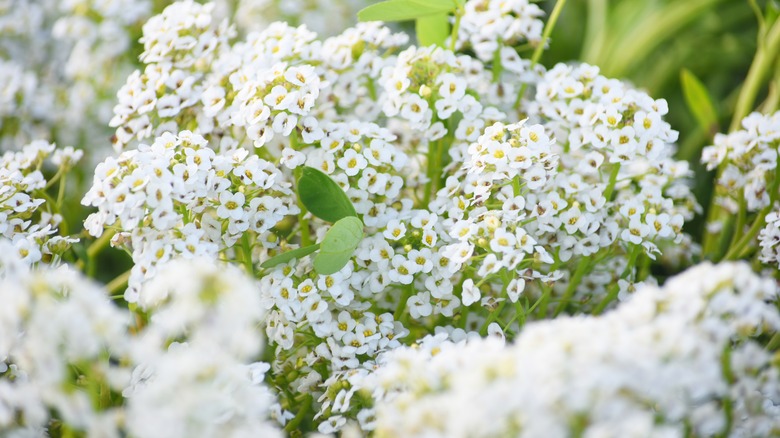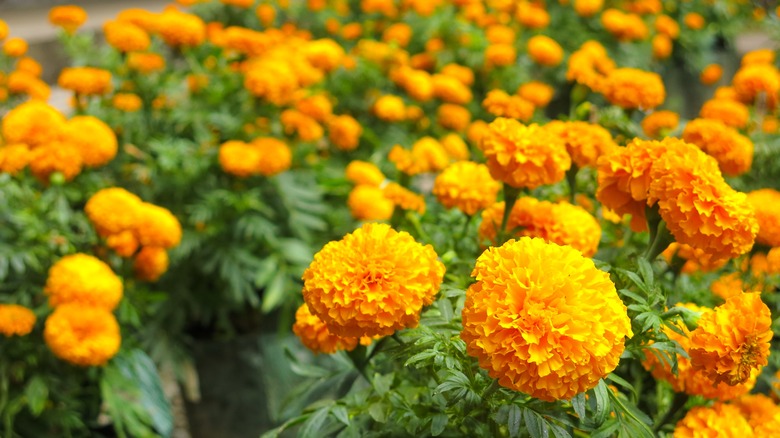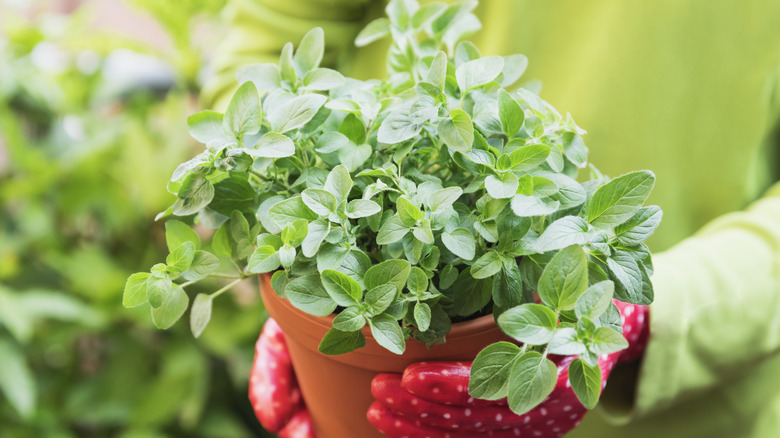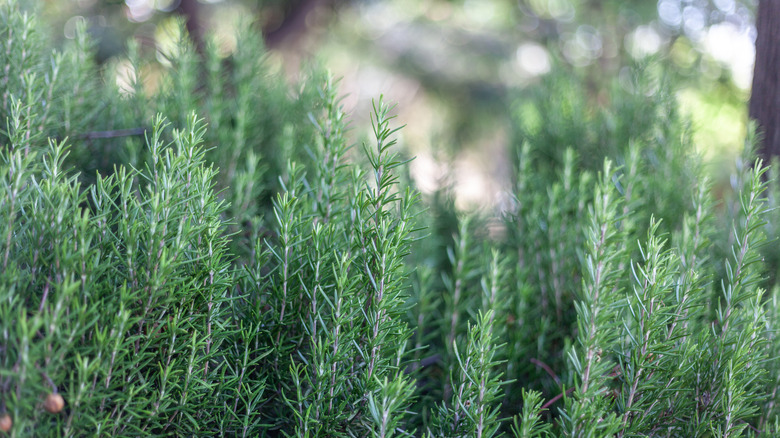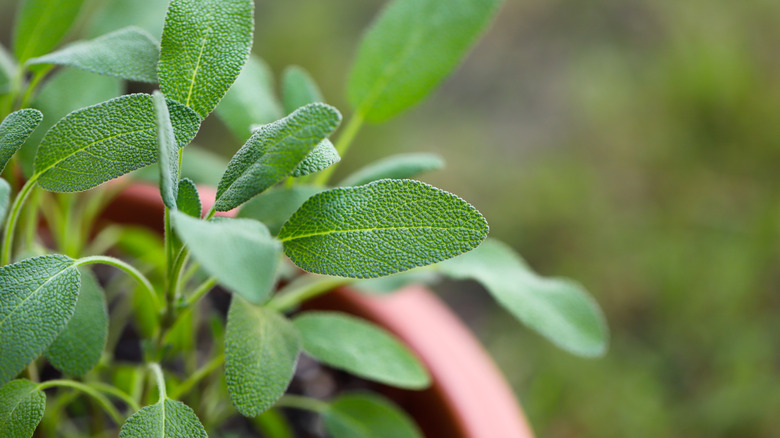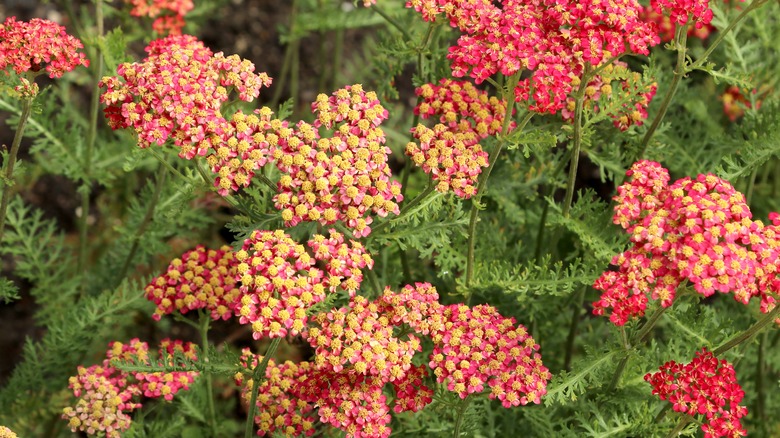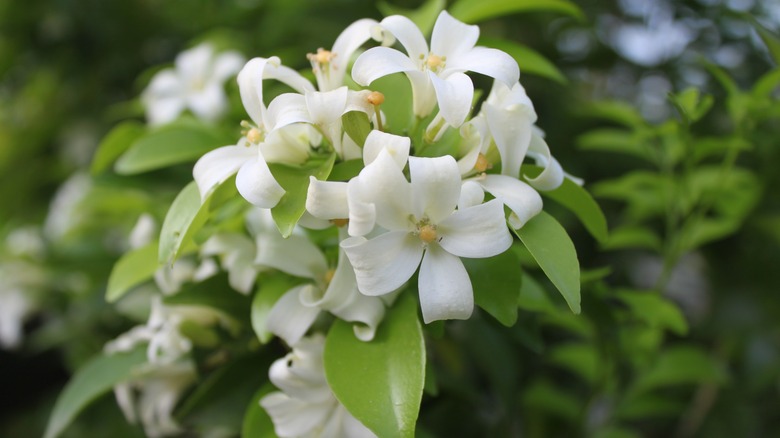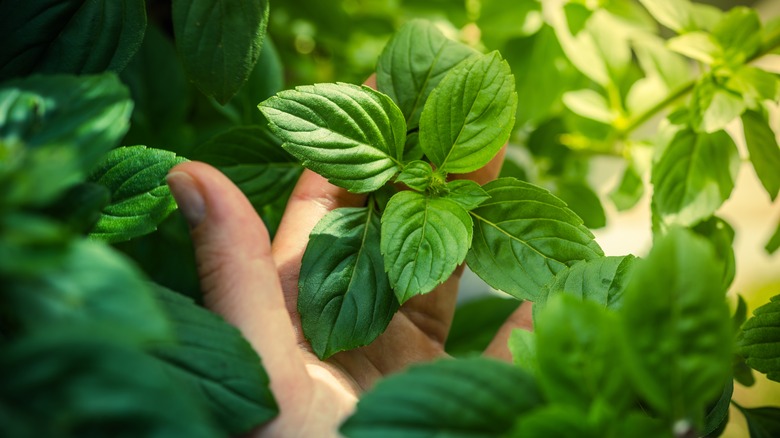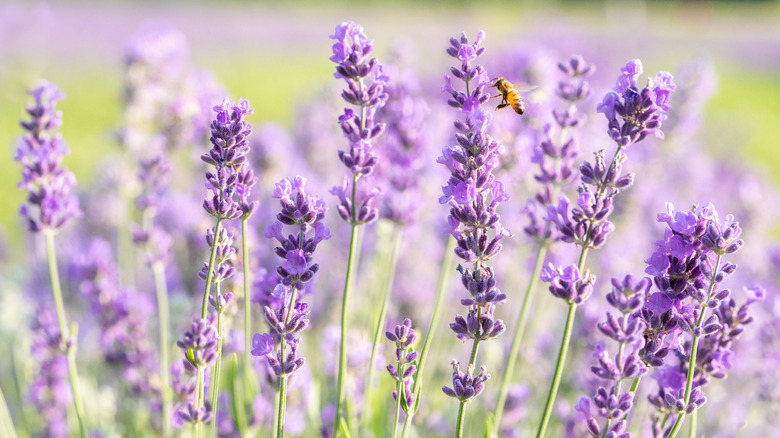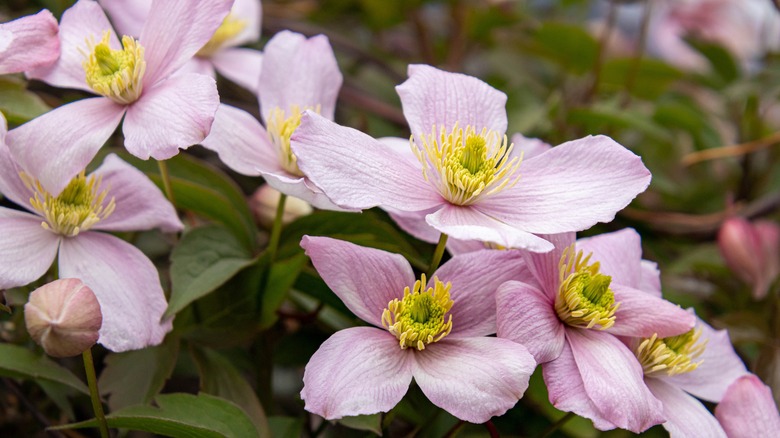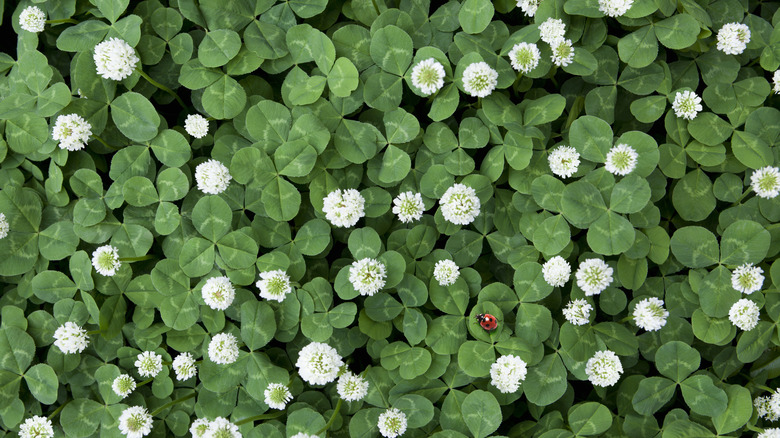12 Herbs & Flowers You Should Grow Alongside Citrus Trees In The Garden
We may receive a commission on purchases made from links.
If you're planning to add citrus trees to your outdoor landscape, you're in for a treat. Not only do they bear tasty fruits and add a little curb appeal, but many are also self-pollinating, making them lower maintenance than you might think. But pests, diseases, and poor growing conditions can put your trees in a bad spot that forces all of their energy to go into fighting to stay alive rather than producing fruit.
Luckily, citrus trees don't need to live alone and can benefit from the addition of a few strategic neighbors. Whether your tree needs help with pests, soil conditions, or you just want some complementary aromas and colors to fill your garden, we've got you covered. Here are 12 herbs and flowers that make excellent neighbors for citrus trees and the science behind why they're so compatible.
Sweet alyssum brings beneficial insects to feast on the citrus tree's pests
Sweet alyssum (Lobularia maritima) is the perfect plant for procrastinators who want a showy garden without the backbreaking work. Sweet alyssum is not only easygoing, but it grows fast and produces a small sea of frothy blooms that can fill gaps in sparsely planted areas quickly. Sweet alyssum's also a powerful ally for citrus trees, thanks to its friends who come along. Sweet alyssum attracts hoverflies, a predatory insect that likes to munch on aphids and Asian citrus psyllids, both of which are harmful to citrus trees. The hoverfly larvae are the primary eaters, and growing bodies need lots of food, so they're voracious predators that will happily chow down on pest populations if given the chance.
A 2019 study published in Insects tested sweet alyssum, along with three other plants, in apple orchards to see which predatory insects it could attract to the orchard, if any. The results were that hoverflies showed up in droves, especially when compared to the control orchard. But they weren't alone — ladybugs, spiders, and green lacewings (whose larvae go by nothing less than the title of "aphid lions") all answered the call put out by sweet alyssum and moved in. It was an insect buffet, and aphids were the main course.
Sweet alyssum likes well-draining soil that stays a little moist. In terms of light requirements, this depends on your climate. If you're someplace where summers get pretty rough, try to give it a little shade during the peak afternoon hours. Full sun conditions tend to be tolerable for the plant in more Northern climates. Have a light hand with fertilizer and watering. Too much water can cause rotting. Too much fertilizer can encourage excess leafy growth instead of abundant blooms.
Marigolds help control nematodes
Marigolds (Tagetes spp.) are like the workhorses of the flower world. One of the many benefits of planting marigolds is as an insect control, and gardeners love them for their ability to attract the good bugs while repelling the, let's say, less than desirable ones. One foe they're really good for protecting citrus trees against is nematodes. A nematode infestation can cause serious damage to citrus trees by, essentially, starving the tree of nutrients until the point of critical failure. Marigolds can act not only as nematode repellers but also destroy them in a pretty gory fashion thanks to a naturally occurring allelochemical in their roots known as α-terthienyl. A 2019 study published in Biology Open found that α-terthienyl could penetrate the nematodes' skin and destroy the pest from the inside out. So yeah, we wouldn't blame any nematodes for wanting to steer clear of your citrus trees once a patch of marigolds gets planted nearby.
African marigolds (Tagetes erecta, which, confusingly, are actually from Mexico) appear to have the highest efficacy rate, but any variety of Tagetes should work well enough. Marigolds aren't picky about soil conditions but do best in moist but well-draining soil. They like to get those pretty yellow-orange blooms out in full sun conditions but wouldn't mind a little shade if your afternoon sun is particularly harsh. Marigolds won't do well in full shade, though, so plant them far enough away from any tree canopies to ensure they have the light they need to push out those big blooms and bust bugs. Being annuals, you can adjust their placement in relation to your citrus tree as its branches expand, each year planting your "golds" a bit further from the trunk, where they'll still get lots of direct sun.
Oregano can attract beneficial bugs for citrus trees
Not all bugs are bad news, and some plants can attract insects that will act like a beefed-up security team for fruit trees. Oregano (Origanum) is one of these species and its strong aromas can bring the bodyguards flocking to your citrus trees. A 2023 study in Insects tested hedgerows of four aromatic plants in orange orchards to see just how well they worked for attracting predatory insects as compared to bare soil or plain old weeds. The researchers found that oregano was one of the best plants for attracting Macrolophus spp., a class of predatory bugs that can decimate soft-bodied pests like aphids, spider mites, thrips, and whiteflies — basically, a bunch of common nuisances gardeners have to deal with regularly. Interestingly, the study also found that the act of planting these aromatic herbs alone was enough to stop future outbreaks and prevent the introduction of any new pests in the orchard.
Unfortunately, oregano isn't an easygoing plant and needs its growing conditions just so to thrive. Oregano likes full sun and well-draining soil that's as close to a neutral pH as possible. It's pretty picky about its pH levels and won't thrive in acidic soils, so you may want to get a soil test first or just keep it in a container if your soil skews acidic or alkaline. It also doesn't do well if the humidity is too high around it, so try to keep your oregano plants spaced out to promote good airflow that can move moisture away from its leaves.
Rosemary attracts spiders who love to prey on citrus pests
Rosemary's scientific name, Salvia rosmarinus, has a pretty epic translation. Salvia comes from the Latin word "salvo," which can mean to heal, save, or be healthy while "rosmarinus" is a portmanteau of ros and marinus that translates to "dew of the sea." While "healing dew of the sea" may not be the first thing that comes to mind when you think of rosemary's scent and appearance, predatory spiders can understand the appeal. The aforementioned 2023 Insects study put organic rosemary up to the task of protecting orange orchards and found hedgerows of the herb to be the second-most effective at attracting parasitoids, which are bugs that act like parasites to pests, latching on and eventually killing their hosts. In addition, rosemary took home the gold medal for being the most appealing spot for predatory spiders once established and settled in. So we think it's safe to say that planting rosemary near your citrus tree can help to ensure pests won't be a problem.
Rosemary is less finicky than oregano and can tolerate most types of soil, as long as it's slightly acidic, well-draining, and not heavy with clay. It likes full sun, but can handle partial shade if necessary. It's native to rocky areas in the Mediterranean so won't tolerate dense, heavy soil or lots of humidity. Keep the airflow moving around it by planting rosemary in an area where it can catch a breeze and keep neighboring plants pruned. If you want to lighten up compacted ground, adding organic matter will increase aeration and is one of the best ways to improve heavy clay garden soil.
Sage attracts pirate bugs which love to eat thrips
Sage (Salvia) is another aromatic herb that brings predatory bugs to take on the role of beefy bouncers for your citrus trees. The 2023 Insects study tested sage hedgerows in orange orchards and found sage drew in significant amounts of pirate bugs (Orius spp.). Pirate bugs aren't picky about which pests they feast on; whatever you've got, they'll at least try a nibble of. However, their favorite food may be thrips, so if you've got a burgeoning infestation, adding a few sage plants could attract pirate bugs to help solve the problem. Plus, sage is awesome at preventing weeds from taking over your garden, so it's got a lot going for it.
Sage plants like full sun but aren't bothered if there's a bit of occasional shade. They like well-draining soil that's full of organic materials to draw nutrients from, so consider mixing in extra goodies to the soil before planting. Some gardeners like to use biochar as an organic material additive, and this Char Bliss Organic Biochar for Plants has lots of positive reviews on Amazon, so it might be worth trialing. But if you want to stick to old favorites, straw, leaf mold, and compost all make useful additives that can give your soil a boost in nutrients which your sage plant should enjoy.
Yarrow brings beneficial buddies and loves the same growing conditions as citrus trees
Yarrow (Achillea millefolium) is another plant that uses the buddy system to make itself helpful to neighboring citrus trees. The 2019 Insects study that tested sweet alyssum in apple orchards also gave yarrow a shot to see what it could do. Researchers noticed an influx of hoverflies, spiders, and other predatory bugs that target aphid colonies, making yarrow a potential BFF for your citrus tree, thanks to the diverse predators it can get to show up. Plus, yarrow attracts dragonflies, a natural mosquito predator, and looks amazing when in bloom, so what's not to love?
Yarrow and citrus trees both love the same growing conditions, full sun and well-draining soil, so it's an easy pairing to make. However, you may want to keep your yarrow in a pot instead of in the ground. Yarrow is one of those plants that can suppress weeds, but also become a nuisance itself that overtakes neighbors thanks to its aggressive rhizome spread and ability to self-seed easily. If your planted yarrow starts to get a little too bushy, divide it and replant to keep it healthy.
Orange jasmine makes a great citrus tree border trap crop
With a name like "orange jasmine" (Murraya paniculata) how could it be anything but a useful neighbor for citrus trees? Not only does it smell incredible on its own, but pairing it with citrus scents will give your garden the most fragrant aroma; it's like having your own perfumery right in your backyard. But orange jasmine's scent doesn't just delight the nose; it's also useful for turning the plant into a successful trap crop. Researchers in a 2019 Scientific Reports study planted orange jasmine as a border around citrus orchards. They found its aroma lured Asian citrus psyllids, a particularly nasty citrus pest, successfully away from the trees. As a bonus, the orange jasmine plants were treated with a pesticide, turning them from trap crops into pest-killing machines. Interestingly, this method was so effective that it wasn't necessary to add insecticides to the trees at all, which is useful for keeping their fruits as chemical-free as possible.
Orange jasmine likes its soil to be well-draining and on the loamy side, full of nutrients and goodies. However, you might run into an issue with that rich, organic matter trapping too much moisture, leading to root rot, so don't go too crazy with additives. One thing you'll need to grow citrus trees and orange jasmine together is space; heights of 20 feet are possible, but 8 to 12 feet is more common. Unfortunately, it's only winter hardy in USDA Zones 10 through 12, so you may want to keep it in a container to bring inside if your climate is less tropical.
Basil plants help increase nitrogen levels in orchard soil
If your soil needs a little help getting more nutrient-rich, consider adding a basil plant (Ocimum basilicum) or two. A 2021 study published in Frontiers in Microbiology tested whether aromatic plants give off more than just strong smells. The study found exudates from the tested aromatic plants' roots did wonders for the soil, significantly increasing organic matter, water content, and nitrogen levels while simultaneously decreasing pH levels. Basil's results were impressive, especially regarding nitrogen fixation — nitrogen levels increased significantly, rising 25.6% during the first year. And since citrus trees are nitrogen-hungry plants, this could be a useful boost that gives your trees the oomph they need to bear some tasty fruits.
Basil needs well-draining soil that retains some moisture and full sun to thrive. If you're having trouble keeping up with basil's moisture needs, add a little mulch around it. All of this consistent moisture can present a problem, though, since basil is susceptible to downy mildew. Space basil plants apart to allow good air circulation to pass through and try watering at the base instead of overhead — this will prevent water from getting on the leaves, a common jumpstart for foliar diseases.
Lavender does a lot for citrus trees and smells great, too
Lavender (Lavandula angustifolia) is another fantastic companion plant that's chock full of benefits. First, let's talk aesthetics — the combination of a lavender bush in full bloom in view of a fruiting citrus tree is incredible. Plus, the smell combination will make you think you're on a Mediterranean vacation. In addition to this sensory paradise, lavender is a pollinator favorite that attracts bees, particularly bumble and honey bees. A 2024 study in Scientific Reports found that citrus trees rely heavily on pollinators to help with fruit production; around 60% of fruit yielded from citrus trees is the result of pollinators. And guess which pollinators do the heavy lifting? The western honey bee. So, putting lavender plants near citrus trees will almost certainly help bring honey bees to your yard and give your tree's fruit production a boost.
To make this pairing even sweeter, lavender and citrus trees love the same growing conditions: Very well-draining, well-aerated soil that can dry out and full sun. Like citrus trees, lavender needs loose soil; clay-heavy or highly compacted ground will make it hard for roots to spread and can hold water under the bush, increasing the likelihood of rot. If you're concerned about too much moisture around your plant, skip the biggest mistakes gardeners make growing lavender and switch out mulch with a layer of small rocks instead. This will help keep the area aerated and remove places where moisture can hide.
Mountain clematis smells amazing and makes a great ground cover
Mountain clematis (Clematis montana) might not be as famous as lavender, but its scent makes an equally intoxicating complement to the freshness of a citrus tree as its purple pal. Gardeners describe it as having a vanilla aroma that fills the air, and its flower colors are just so pretty against the mellow yellow, green, and orange hues of ripening citrus fruits. Mountain clematis grows as a vine, giving it potential as a flower that climbs a border trellis around the orchard or even as a pretty pastel ground cover.
Mountain clematis needs soil that's rich in organic matter and well-draining. They can grow in full sun or partial shade but may need a layer of mulch underneath in hot sun climates to keep their roots cool and moist. It, too, is a pollinator-friendly plant that can bring bees over to your citrus trees, and may be less high-maintenance about its care than lavender. If you give it a trellis and make it happy, your mountain clematis can climb up to 40 feet high. If you'd rather use it as an orchard-adjacent groundcover, expect it to get anywhere from 8 to 15 feet wide.
Microclover fixes nitrogen and makes a good citrus tree cover crop
Let's say you have a soil test done and your results show that nitrogen levels are down; what should you do? Unfortunately, you can't just pop some citrus trees in and hope for the best, as most citrus species are voracious consumers of nitrogen. You should start by amending the area with natural ingredients that give your soil a nitrogen boost. To help carry out your soil-amending job, you can also plant a nitrogen fixer — and that's when clover leaps off the bench, ready for action. Clover's roots are powerhouse helpers, infusing soil with nitrogen and breaking up compacted soil. Clover is so good at this job that it's considered a great cover crop specifically for citrus orchards.
The only downside is that many clover species are invasive in the U.S., and we would not recommend planting ordinary white clover as it can be hard to get rid of (especially in lawns) and has the potential to spread into the surrounding ecosystem. Fortunately, there are clover varieties that have less aggressive growth habits, most notably, microclovers, which are smaller dwarf varieties of Trifolium repens, such as 'Pirouette' and 'Pipolina'.
Microclovers will thrive in full sun and handle light shade– making them ideal for growing beneath a well-pruned fruit tree. Microclover is tolerant of wet soil conditions but also drought resistant. To plant, simply rake the soil, spread your seeds, and keep the area moist until they have established. If you are looking for seeds, OutsidePride is a trusted supplier, and their Perennial White MiniClover Seed packs have a bevy of glowing reviews on Amazon.
